Landscape Aesthetics and the Scenic Drivers of Amenity Migration in the New West: Naturalness, Visual Scale, and Complexity
Abstract
:1. Introduction
1.1. Natural Amenities and Visual Quality
1.1.1. Naturalness: Greenness
1.1.2. Visual Scale: Viewshed Size
1.1.3. Complexity: Terrain Ruggedness
1.2. Preference Scale and Viewshed Analysis
2. Study Area and Methods
2.1. Study Area
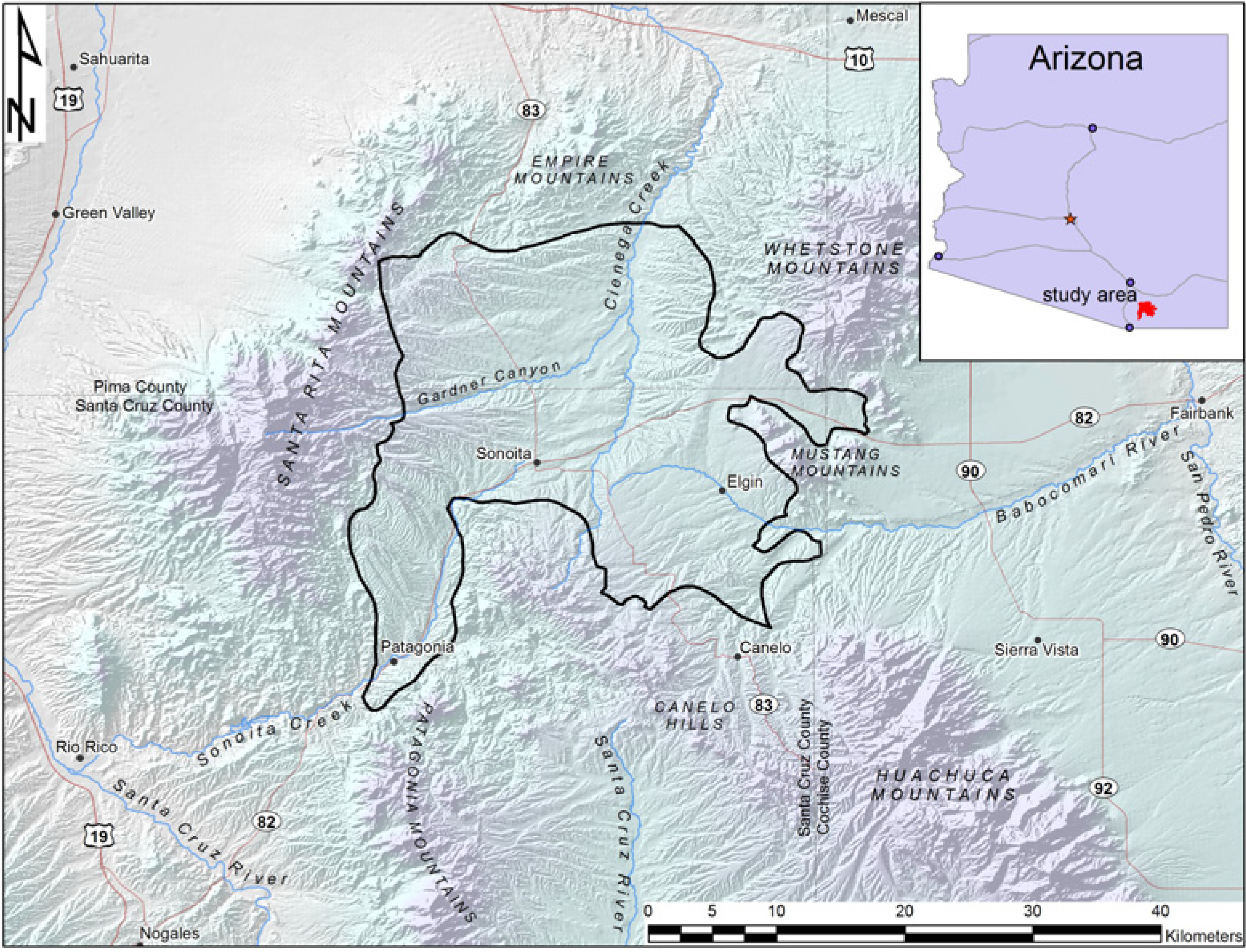
| 2010 Census Figures | Median Household Income ($) | Median House Value ($) | Income Below Poverty Level (% Population) | Median Age (Years) |
|---|---|---|---|---|
| Sonoita Plain, AZ | 62,984 | 368,421 | 6.1 | 58.0 |
| Santa Cruz County, AZ | 35,707 | 125,907 | 24.5 | 31.8 |
| Arizona | 48,745 | 187,700 | 13.9 | 34.2 |
2.2. Methods
2.2.1. Deriving Contextual Variables
2.2.2. Viewshed Analysis
2.2.3. Greenness
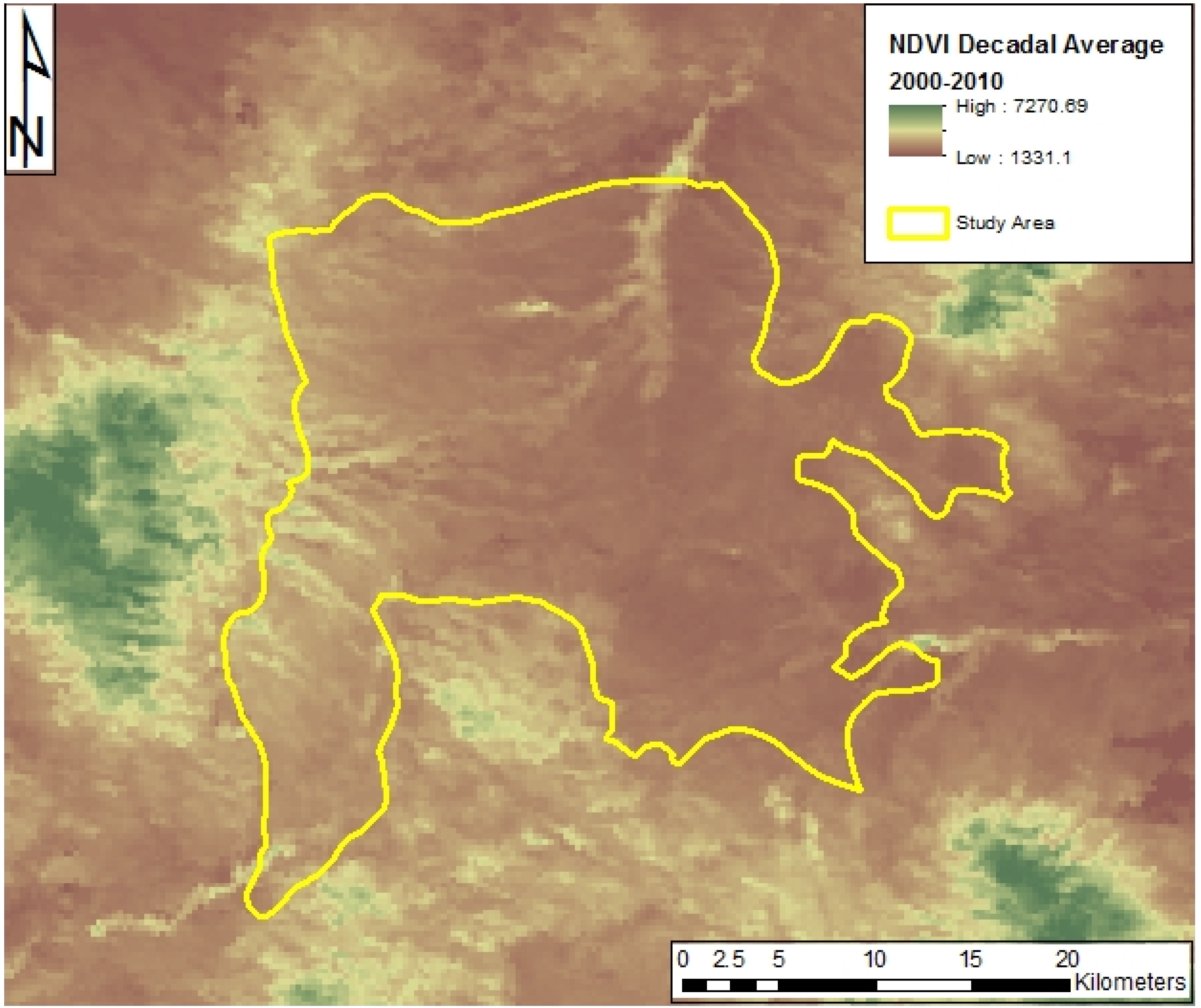
2.2.4. Viewshed Size
2.2.5. Terrain Ruggedness
 [102]. Two 3 × 3 neighborhood rasters were created from the DEM: maximum value (maxDEM) and minimum value (minDEM). A raster calculator was then used to compute the TRI for each cell of the study area using the two neighborhood inputs (Figure 3). The viewshed of each exurban house, as well as of each simulated (validation) house, was overlaid on the TRI surface. The grid cell-level TRI values that fell within each viewshed (i.e., are visible from that house) were then averaged for a total TRI. We also calculated the maximum TRI value in each viewshed.
[102]. Two 3 × 3 neighborhood rasters were created from the DEM: maximum value (maxDEM) and minimum value (minDEM). A raster calculator was then used to compute the TRI for each cell of the study area using the two neighborhood inputs (Figure 3). The viewshed of each exurban house, as well as of each simulated (validation) house, was overlaid on the TRI surface. The grid cell-level TRI values that fell within each viewshed (i.e., are visible from that house) were then averaged for a total TRI. We also calculated the maximum TRI value in each viewshed.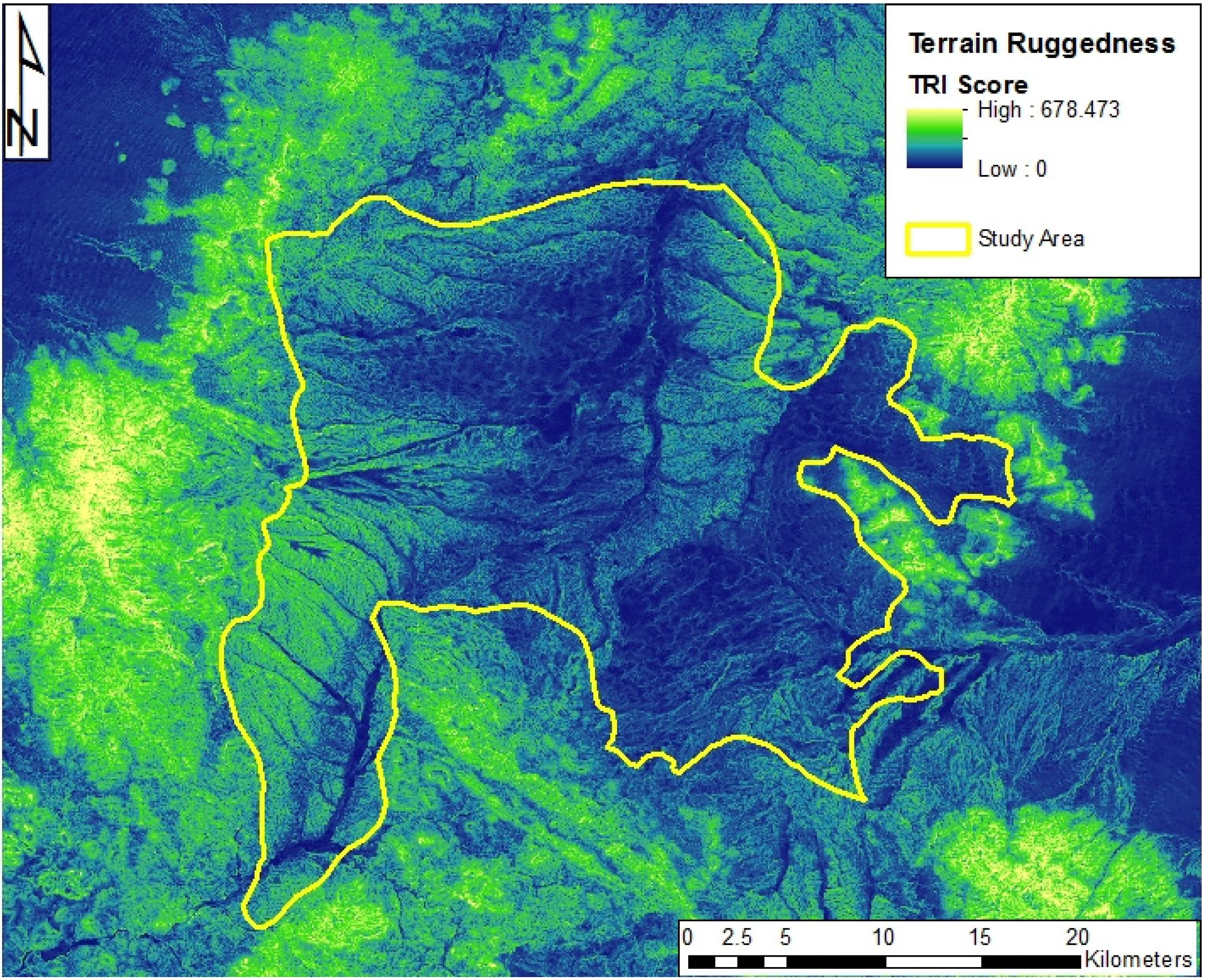
| Category | Elevation Difference (m) |
|---|---|
| Level | 0–80 |
| Nearly Level | 81–116 |
| Slightly Rugged | 117–161 |
| Intermediately Rugged | 162–239 |
| Moderately Rugged | 240–497 |
| Highly Rugged | 498–958 |
| Extremely Rugged | 959–4367 |
2.2.6. Validation
 │F1,n(x) − F2,n′(x)│, where F1,n and F2,n′ are the distribution functions of the first and second sample respectively [111]. In total, four tests were performed: average NDVI, viewshed size, total (average) TRI, and maximum TRI. The result h is 1 if the test rejects the null hypothesis (same continuous distribution) at the 5% significance level; otherwise it is 0. The test statistic k is the maximum difference between the curves [111]. The two-sample K-S test is distribution free and valid for testing data against any continuous distribution [112].
│F1,n(x) − F2,n′(x)│, where F1,n and F2,n′ are the distribution functions of the first and second sample respectively [111]. In total, four tests were performed: average NDVI, viewshed size, total (average) TRI, and maximum TRI. The result h is 1 if the test rejects the null hypothesis (same continuous distribution) at the 5% significance level; otherwise it is 0. The test statistic k is the maximum difference between the curves [111]. The two-sample K-S test is distribution free and valid for testing data against any continuous distribution [112].3. Results and Discussion
3.1. Results
3.1.1. Greenness
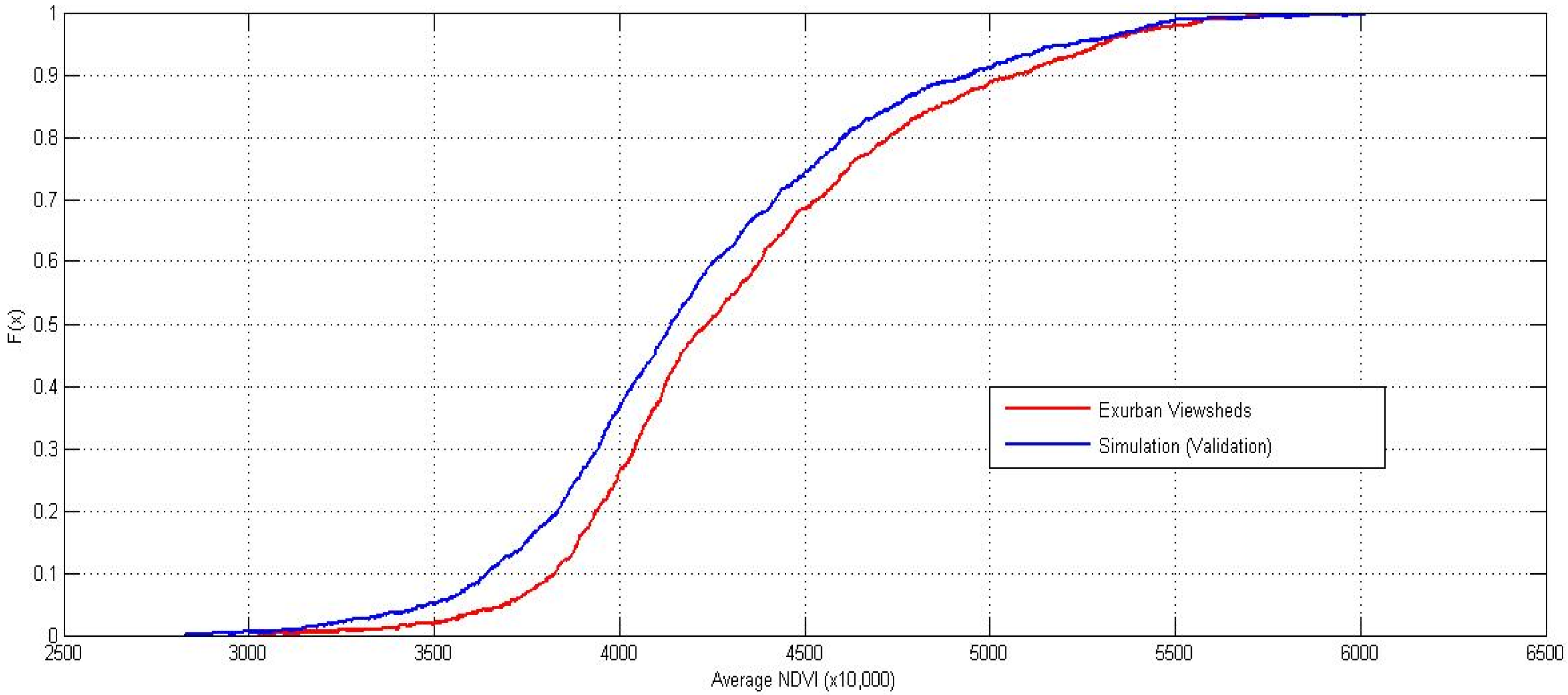
3.1.2. Viewshed Size
| Comparison between Actual Exurban Distribution and Simulated Distribution | h a | p-Value | k b |
|---|---|---|---|
| Mean NDVI Value | 1 | <0.0001 | 0.1152 |
| Size | 1 | 0.0105 | 0.0721 |
| Total (Mean) TRI Value | 1 | <0.0001 | 0.1112 |
| Maximum TRI Value | 1 | <0.0001 | 0.2565 |
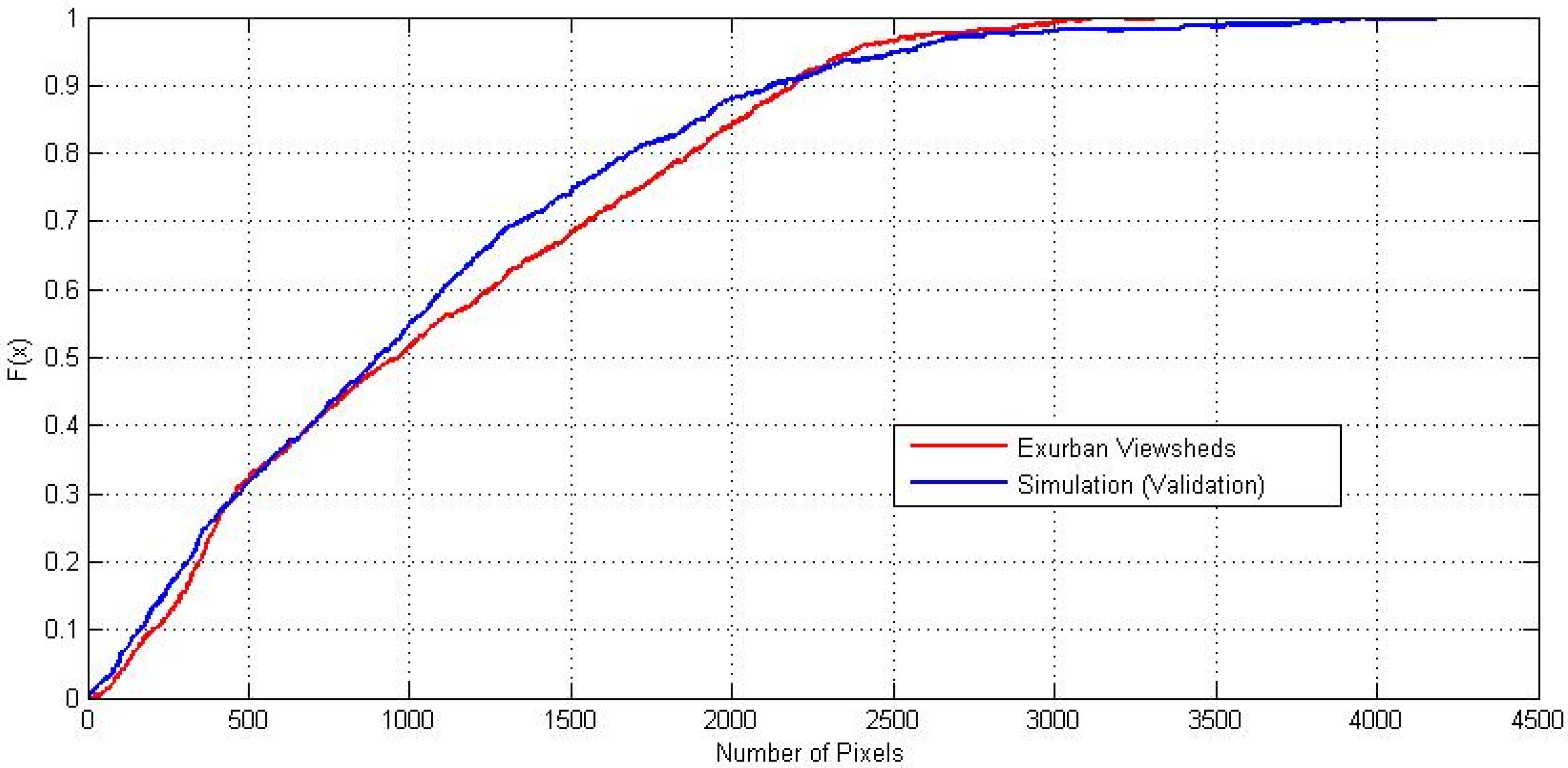
3.1.3. Terrain Ruggedness
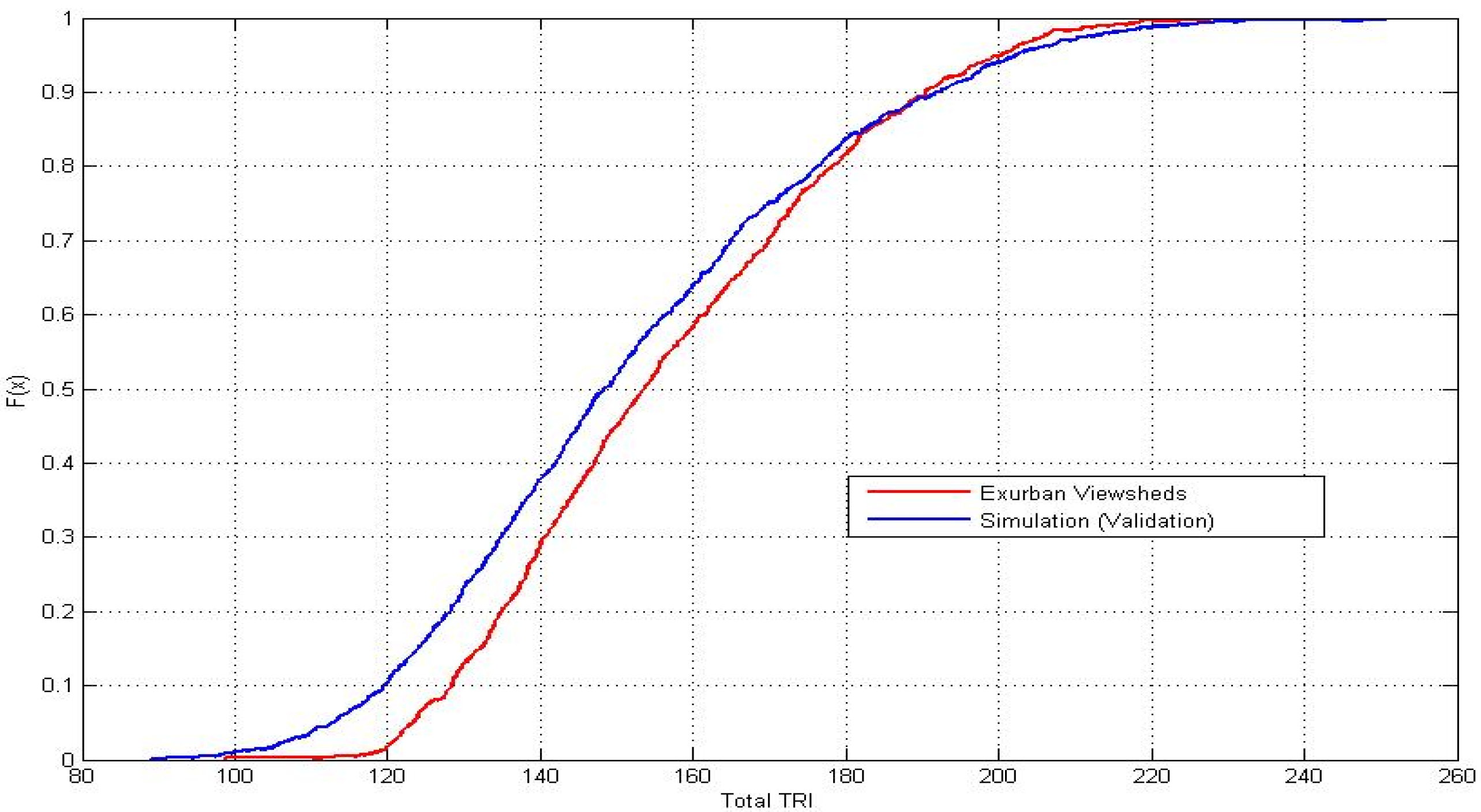
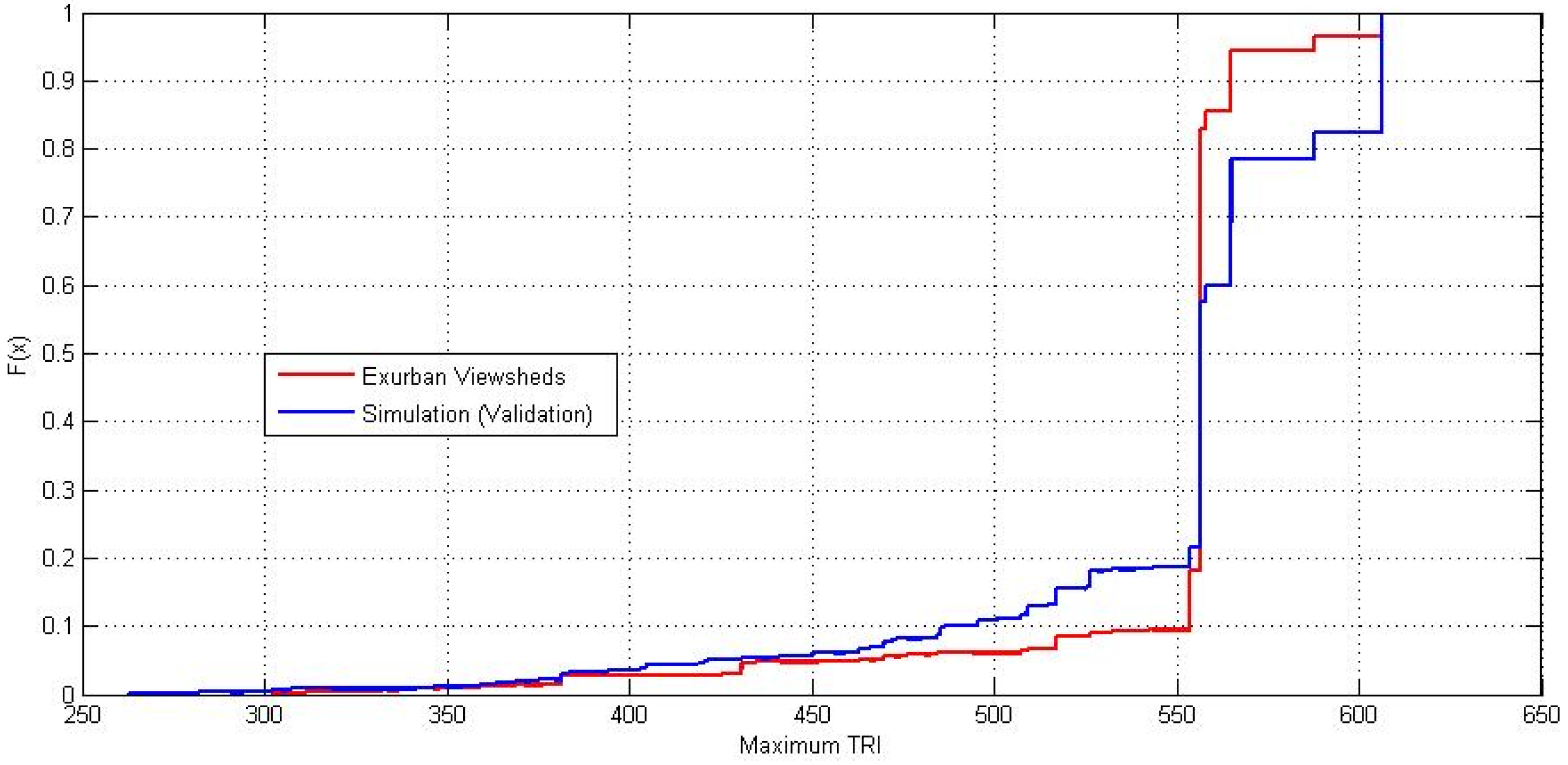
3.2. Discussion
4. Conclusions
Acknowledgments
Author Contributions
Conflicts of Interest
References
- Smith, M.D.; Kannich, R.S. Culture clash revisited: Newcomer and longer-term residents’ attitudes toward land use, development, and environmental issues in rural communities in the Rocky Mountain West. Rural Sociol. 2000, 65, 396–421. [Google Scholar] [CrossRef]
- Rudzitis, G.; Marcouiller, D.; Lorah, P. The rural rich and their housing: Spatially addressing the “haves”. In Rural Housing, Exurbanzation, and Amenity-Driven Development; Marcouiller, D., Lapping, M., Furuseth, O., Eds.; Ashgate Publishing Company: Burlington, VT, USA, 2011; pp. 129–157. [Google Scholar]
- Taylor, L. No boundaries: Exurbia and the study of contemporary urban dispersion. GeoJournal 2011, 76, 323–339. [Google Scholar] [CrossRef]
- Hines, J.D. The post-industrial regime of production/consumption and the rural gentrification of the New West Archipelago. Antipode 2011, 44, 74–97. [Google Scholar] [CrossRef]
- McCarthy, J. Rural geography: Globalizing the countryside. Prog. Hum. Geogr. 2008, 32, 129–137. [Google Scholar] [CrossRef]
- Theobald, D.M. Land-use dynamics beyond the American urban fringe. Geogr. Rev. 2001, 91, 544–564. [Google Scholar] [CrossRef]
- Theobald, D.M. Landscape patterns of exurban growth in the USA from 1980 to 2020. Ecol. Soc. 2005, 10, 32. [Google Scholar]
- Rudzitis, G. Amenities increasingly draw people to the rural West. Rural Dev. Perspect. 1999, 14, 9–13. [Google Scholar]
- Shumway, J.M.; Otterstrom, S.M. Spatial patterns of migration and income change in the Mountain West: The dominance of service-based, amenity-rich counties. Prof. Geogr. 2001, 53, 492–502. [Google Scholar] [CrossRef]
- Vias, A.C.; Carruthers, J.I. Regional development and land use change in the Rocky Mountain West, 1982–1997. Growth Chang. 2005, 36, 244–272. [Google Scholar] [CrossRef]
- Travis, W.R. New Geographies of the American West: Land Use and the Changing Patterns of Place; Island Press: Washington, DC, USA, 2007. [Google Scholar]
- Power, T.M.; Barrett, R.N. Post-Cowboy Economics: Pay and Prosperity in the New American West; Island Press: Washington, DC, USA, 2001. [Google Scholar]
- Gosnell, H.; Abrams, J. Amenity migration: Diverse conceptualizations of drivers, socioeconomic dimensions, and emerging challenges. GeoJournal 2011, 76, 303–322. [Google Scholar] [CrossRef]
- Riebsame, W.E. (Ed.) Atlas of the New West: Portrait of a Changing Region; W.W. Norton: New York, NY, USA, 1997.
- Power, T.M. Lost Landscapes and Failed Economies: The Search for a Value of Place; Island Press: Washington, DC, USA, 1996. [Google Scholar]
- Cadieux, K.V.; Hurley, P.T. Amenity migration, exurbia, and emerging rural landscapes: Global natural amenity as place and as process. GeoJournal 2011, 76, 297–302. [Google Scholar] [CrossRef]
- Hansen, A.J.; Knight, R.L.; Marzluff, J.M.; Powell, S.; Brown, K.; Gude, P.H.; Jones, K. Effects of exurban development on biodiversity: Patterns, mechanisms, and research needs. Ecol. Appl. 2005, 15, 1893–1905. [Google Scholar] [CrossRef]
- Winkler, R.; Field, D.R.; Luloff, A.E.; Krannich, R.S.; Williams, T. Social landscapes of the Intermountain West: A comparison of “Old West” and “New West” communities. Rural Sociol. 2007, 72, 478–501. [Google Scholar] [CrossRef]
- Sayre, N.F. Ranching, Endangered Species, and Urbanization in the Southwest: Species of Capital; University of Arizona Press: Tucson, AZ, USA, 2006. [Google Scholar]
- Vogt, C.A. Natural resources and exurban housing: Landscapes in transition. In Rural Housing, Exurbanzation, and Amenity-Driven Development; Marcouiller, D., Lapping, M., Furuseth, O., Eds.; Ashgate Publishing Company: Burlington, VT, USA, 2011; pp. 95–113. [Google Scholar]
- Kondo, M.C.; Rivera, R.; Rullman, S., Jr. Protecting the idyll but not the environment: Second homes, amenity migration and rural exclusion in Washington State. Landsc. Urban Plan. 2012, 106, 174–182. [Google Scholar] [CrossRef]
- Ewing, R. Characteristics, causes, and effects of sprawl: A literature review. Environ. Urban Issues 1994, 21, 1–15. [Google Scholar]
- Clark, J.K.; McChesney, R.; Munroe, D.K.; Irwin, E.G. Spatial characteristics of exurban settlement pattern in the United States. Landsc. Urban Plan. 2009, 90, 178–188. [Google Scholar] [CrossRef]
- Vukomanovic, J.; Doumas, S.L.; Osterkamp, W.R.; Orr, B.J. Housing density and ecosystem function: Comparing the impacts of rural, exurban, and suburban densities on fire hazard, water availability, and house and road distance effects. Land 2013, 2, 656–677. [Google Scholar] [CrossRef]
- Forman, R.T.T.; Sperling, D.; Bissonette, J.A.; Clevenger, A.P.; Cutshall, C.D.; Dale, V.H.; Fahrig, L.; France, R.L.; Goldman, C.R.; Heanue, K.; et al. Road Ecology: Science and Solutions; Island Press: Washington, DC, USA, 2003. [Google Scholar]
- Findlay, C.S.; Bourdages, J. Response time of wetland biodiversity to road construction on adjacent lands. Conserv. Biol. 2000, 14, 86–94. [Google Scholar] [CrossRef]
- Mech, L.D.; Fritts, S.H.; Raddle, G.L.; Paul, W.J. Wolf distribution and road density in Minnesota. Wildl. Soc. Bull. 1988, 16, 85–87. [Google Scholar]
- Mladenoff, D.J.; Sickley, T.A.; Haigh, R.G.; Wydeven, A.P. A regional landscape analysis of favorable gray wolf habitat in the northern Great Lakes region. Conserv. Biol. 1995, 9, 37–44. [Google Scholar]
- Van Dyke, F.B.; Brocke, R.H.; Shaw, H.G.; Ackerman, B.B.; Hemker, T.P.; Lindzey, F.G. Reactions of mountain lions to logging and human activity. J. Wildl. Manag. 1986, 50, 95–102. [Google Scholar] [CrossRef]
- Marans, R.W.; Vogt, C.A.; Chazan, D.; Cain, C.; Hansen, B. Understanding Landscape Change: A Preliminary Report on the Dynamics of Residential Choice; Survey Research Center, Institute for Social Research, University of Michigan: Ann Arbor, MI, USA, 2001. [Google Scholar]
- Green, N. On the move: Technology, mobility, and the mediation of social time and space. Inf. Soc. 2002, 18, 281–292. [Google Scholar] [CrossRef]
- Stewart, S.I.; Johnson, K.M. Balancing leisure and work: Evidence from the seasonal home. In Proceedings of the 2005 Northeast Recreation Research Conference; GTR-NE-341; Peden, J., Schuster, R., Eds.; USDA Forest Service, Northeastern Research Station: Newtown Square, PA, USA, 2006; pp. 144–150. [Google Scholar]
- Marcoullier, D.W.; Clendenning, J.G.; Kedzior, R. Natural amenity-led development and rural planning. J. Plan. Lit. 2002, 16, 515–542. [Google Scholar] [CrossRef]
- Walker, P.; Fortmann, L. Whose landscape? A political ecology of the “exurban” Sierra. Cult. Geogr. 2003, 10, 469–491. [Google Scholar] [CrossRef]
- Hines, J.D. The persistent frontier & the rural gentrification of the Rocky Mountain West. J. West. 2007, 46, 63–73. [Google Scholar]
- McGranahan, D.A. Landscape influence on recent rural migration in the U.S. Landsc. Urban Plan. 2008, 85, 228–240. [Google Scholar] [CrossRef]
- Landscape and the Ideology of Nature in Exurbia: Green Sprawl; Cadieux, K.V.; Taylor, L. (Eds.) Routledge: Chicago, IL, USA, 2013.
- Rudzitis, G.; Johansen, H.E. Migration into western wilderness counties: Causes and consequences. West. Wildlands 1989, 15, 19–23. [Google Scholar]
- Rudzitis, G.; Johansen, H.E. How important is wilderness? Results from a United States survey. Environ. Manag. 1991, 15, 227–233. [Google Scholar] [CrossRef]
- Rasker, R. Wilderness for its own sake or as economic asset. J. Land Resour. Environ. Law 2005, 25, 15. [Google Scholar]
- Johnson, J.D.; Rasker, R. The role of economic and quality of life values in rural business location. J. Rural Stud. 1995, 11, 405–416. [Google Scholar] [CrossRef]
- Tveit, M.; Ode, Å.; Fry, G. Key concepts in a framework for analyzing visual landscape character. Landsc. Res. 2006, 31, 229–255. [Google Scholar] [CrossRef]
- Hartig, T. Nature experience in transactional perspective. Landsc. Urban Plan. 1993, 25, 17–36. [Google Scholar] [CrossRef]
- Ode, Å.; Fry, G.; Tveit, M.S.; Messager, P.; Miller, D. Indicators of perceived naturalness as drivers of landscape preference. J. Environ. Manag. 2009, 90, 375–383. [Google Scholar] [CrossRef]
- Purcell, A.T.; Lamb, R.J. Preference and naturalness: An ecological approach. Landsc. Urban Plan. 1998, 42, 57–66. [Google Scholar] [CrossRef]
- Lindhagen, A.; Hörnsten, L. Forest recreation in 1977 and 1997 in Sweden: Changes in public preferences and behavior. Forestry 2000, 73, 143–151. [Google Scholar] [CrossRef]
- Real, E.; Arce, C.; Sabucedo, J.M. Classification of landscape using quantitative and categorical data, and prediction of their scenic beauty in north-western Spain. J. Environ. Psychol. 2000, 20, 355–373. [Google Scholar] [CrossRef]
- Hands, D.E.; Brown, R.D. Enhancing visual preference of ecological rehabilitation sites. Landsc. Urban Plan. 2002, 58, 57–70. [Google Scholar] [CrossRef]
- Hägerhäll, C.M.; Purcell, T.; Taylor, R. Fractal dimension of landscape silhouette outlines as a predictor of landscape preference. J. Environ. Psychol. 2004, 24, 247–255. [Google Scholar] [CrossRef]
- Purcell, T.; Peron, E.; Berto, R. Why do preferences differ between scene types? Environ. Behav. 2001, 33, 93–106. [Google Scholar] [CrossRef]
- Van den Berg, A.E.; Koole, S.L.; van der Wulp, N.Y. Environmental preference and restoration: (How) are they related? J. Environ. Psychol. 2003, 23, 135–146. [Google Scholar] [CrossRef]
- Hartig, T.; Henk, S. Linking preference for environments with their restorative quality. In From Landscape Research to Landscape Planning: Aspects of Integration, Education and Application; Springer: Heidelberg, Germany, 2005; pp. 279–292. [Google Scholar]
- Maas, J.; Verheij, R.A.; Groenewegen, P.P.; de Vries, S.; Spreeuwenberg, P. Green space, urbanity, and health: How strong is the relation? J. Epidemiol. Community Health 2006, 60, 587–592. [Google Scholar] [CrossRef]
- Maas, J.; van Dillne, S.M.; Verheij, R.A.; Groenewegen, P.P. Social contacts as a possible mechanisms behind the relation between green space and health. Health Place 2009, 15, 586–595. [Google Scholar] [CrossRef]
- Rodriguez, D.A.; Brown, A.L.; Troped, P.J. Portable global positioning units to complement accelerometery-based physical activity monitors. Med. Sci. Sports Exerc. 2005, 37, S572–S581. [Google Scholar]
- McGinn, A.P.; Evenson, K.R.; Herring, A.H.; Huston, S.L.; Rodriguez, D.A. Exploring associations between physical activity and perceived and objective measures of the built environment. J. Urban Healt. 2007, 84, 162–184. [Google Scholar] [CrossRef]
- Cohen, D.A.; McKenzie, T.L.; Sehgal, A.; Williamson, S.; Golinelli, D.; Lurie, N. Contribution of public parks to physical activity. Am. J. Public Health 2007, 97, 509–514. [Google Scholar] [CrossRef]
- Bell, J.F.; Wilson, J.S.; Lui, G.C. Neighborhood greenness and 2-year changes in body mass index of children and youth. Am. J. Prev. Med. 2008, 35, 547–553. [Google Scholar] [CrossRef]
- Kawachi, I.; Berkman, L.F. (Eds.) Neighborhoods and Health; Oxford University Press: New York, NY, USA, 2003.
- Mcintyre, S.; Macdonald, L.; Ellaway, A. Lack of agreement between measured and self-reported distance from public green parks in Glasgow, Scotland. Int. J. Behav. Nutr. Phys. Act. 2008, 5, 26. [Google Scholar] [CrossRef]
- Sengupta, S.; Osgood, D.E. The value of remoteness: A hedonic estimation of ranchette prices. Ecol. Econ. 2003, 44, 91–103. [Google Scholar] [CrossRef]
- Smith, D.P.; Phillips, D. Socio-cultural representations of greentrified Pennine rurality. J. Rural Stud. 2001, 17, 457–469. [Google Scholar] [CrossRef]
- Ulrich, R.S. Human responses to vegetation and landscapes. Landsc. Urban Plan. 1986, 13, 29–44. [Google Scholar] [CrossRef]
- Nasar, J.L.; Julian, D.; Buchman, S.; Humphreys, D.; Mrohaly, M. The emotional quality of scenes and observation points: A look at prospect and refuge. Landsc. Urban Plan. 1983, 10, 355–361. [Google Scholar] [CrossRef]
- Hanyu, K. Visual properties and affective appraisals in residential areas in daylight. J. Environ. Psychol. 2000, 20, 273–284. [Google Scholar] [CrossRef]
- Clay, G.R.; Smidt, R.K. Assessing the validity and reliability of descriptor variables used in scenic highway analysis. Landsc. Urban Plan. 2004, 66, 239–255. [Google Scholar] [CrossRef]
- Appleton, J. The Experience of Landscape; Wiley: London, UK, 1975. [Google Scholar]
- Germino, M.J.; Reiners, W.A.; Blasko, B.J.; McLeod, D.; Bastian, C.T. Estimating visual properties of Rocky Mountain landscapes using GIS. Landsc. Urban Plan. 2001, 53, 71–83. [Google Scholar] [CrossRef]
- Weinstoerffer, J.; Girardin, P. Assessment of the contribution of land use pattern and intensity to landscape quality: Use of a landscape indicator. Ecol. Model. 2000, 130, 95–109. [Google Scholar] [CrossRef]
- Litton, R.B. Aesthetic dimensions of the landscape. In Natural Environments: Studies in Theoretical and Applied Analysis; Krutilla, J.V., Ed.; John Hopkins University Press: Baltimore, MD, USA, 1972; pp. 262–291. [Google Scholar]
- Kaplan, R.; Kaplan, S. The Experience of Nature; Cambridge University Press: Cambridge, UK, 1989. [Google Scholar]
- Stamps, A.E. Mystery, complexity, legibility and coherence. J. Environ. Psychol. 2004, 24, 1–16. [Google Scholar] [CrossRef]
- Hunziker, M.; Kienast, F. Potential impacts of changing agricultural activities on scenic beauty: A prototypical technique for automated rapid assessment. Landsc. Ecol. 1999, 14, 161–176. [Google Scholar] [CrossRef]
- Dramstad, W.E.; Fry, G.; Fjellstad, W.J.; Skar, B.; Helliksen, W.; Sollund, M.L.B.; Tveit, M.S.; Geelmuyden, A.K.; Framstad, E. Integrating landscape-based values: Norwegian monitoring of agricultural landscapes. Landsc. Urban Plan. 2001, 57, 257–268. [Google Scholar] [CrossRef]
- Fjellstad, W.J.; Dramstad, W.E.; Strand, G.-H.; Fry, G.L.A. Heterogeneity as a measure of spatial pattern for monitoring agricultural landscapes. Norsk Geogr. Tidsk. 2001, 55, 71–76. [Google Scholar] [CrossRef]
- Palmer, J.F. Using spatial metrics to predict scenic perception in a changing landscape: Dennis, Massachusetts. Landsc. Urban Plan. 2004, 69, 201–218. [Google Scholar] [CrossRef]
- U.S. Geological Survey. The National Atlas of the United States of America; US Department of the Interior: Washington, DC, USA, 1937.
- McGranahan, D.A. Natural Amenities Drive Rural Population Change; AER781; Economic Research Service, U.S. Department of Agriculture: Washington, CD, USA, 1999.
- Mueser, P.R.; Graves, P.E. Examining the role of economic opportunities and amenities in explaining population redistribution. J. Urban Econ. 1995, 37, 176–200. [Google Scholar] [CrossRef]
- Luttik, J. The value of trees, water and open space as reflected by house prices in the Netherlands. Landsc. Urban Plan. 1999, 48, 8–16. [Google Scholar]
- Fisher, P.F. 1st experiments in viewshed uncertainty—The accuracy of the viewshed area. Photogramm. Eng. Remote Sens. 1991, 57, 1321–1327. [Google Scholar]
- Gimblett, H.R. Viewshed protection. In The Encyclopedia of Sustainability, Vol. 6: Measurements, Indicators, and Research Methods for Sustainability; Fogel, D., Fredericks, S., Harrington, L., Spellerberg, I., Eds.; Berkshire Publishing: Great Barrington, MA, USA, 2012; pp. 402–406. [Google Scholar]
- Zhou, D.; Wang, B.J.; Shi, B. GIS viewshed analysis of visual pollution assessment for mine environment. J. Guilin Univ. Technol. 2011, 31, 207–212. [Google Scholar]
- Domingo-Santos, J.M.; Fernández de Villarán, R.; Rapp-Arrarás, I.; Corral-Pazos de Provens, E. The visual exposure in forest and rural landscapes: An algorithm and a GIS tool. Landsc. Urban Plan. 2011, 101, 52–58. [Google Scholar] [CrossRef]
- Alexakis, D.; Sarris, A.; Astaras, T.; Albanakis, K. Integrated GIS, remote sensing and geomorphologic approaches for the reconstruction of the landscape habitation of Thessaly during the Neolithic period. J. Archaeol. Sci. 2011, 38, 89–100. [Google Scholar] [CrossRef]
- Brabyn, L.; Mark, D.M. Using viewsheds, GIS, and a landscape classification to tag landscape photographs. Appl. Geogr. 2011, 31, 1115–1122. [Google Scholar] [CrossRef]
- Sherren, K.; Fischer, J.; Pink, J.; Stott, J.; Stein, J.; Yoon, H.-J. Australian graziers value sparse trees in their pastures: A viewshed analysis of photo-elicitation. Soc. Nat. Resour. 2011, 24, 412–422. [Google Scholar] [CrossRef]
- Walker, P. Commentary for special issue of GeoJournal on amenity migration, exurbia, and emerging rural landscapes. GeoJournal 2011, 76, 441–444. [Google Scholar] [CrossRef]
- 1/3 Arc-Second DEM Layer (Raster File). Available online: http://nationalmap.gov/viewer.html (accessed on 17 June 2011).
- Bock, C.E.; Bock, J.H. The View from Bald Hill; University of California Press: Berkeley, CA, USA, 2000. [Google Scholar]
- Natural Vegetation. Available online: https://arcgis2.geo.az.gov/portal/natural-vegetation (accessed on 9 March 2011).
- USGS National Gap Analysis Program; RS/GIS Laboratory; College of Natural Resources, Utah State University. Provisional Digital Land Cover Map for the Southwestern United States; Version 1.0; U.S. Department of the Interior: Washington, DC, USA; U.S. Geological Survey: Reston, VA, USA, 2004.
- Kupfer, J.A.; Miller, J.D. Wildfire effects and post-fire responses of an invasive mesquite population: The interactive importance of grazing and non-native herbaceous species invasion. J. Biogeogr. 2005, 32, 453–466. [Google Scholar] [CrossRef]
- Leinwand, I.I.F.; Theobald, D.M.; Mitchell, J.; Knight, R.L. Landscape dynamics at the private-public interface: A case study in Colorado. Landsc. Urban Plan. 2010, 97, 182–193. [Google Scholar] [CrossRef]
- Tucker, C.J. Red and photographic infrared linear combinations for monitoring vegetation. Remote Sens. Environ. 1979, 8, 127–150. [Google Scholar] [CrossRef]
- Lenney, M.P.; Woodcock, C.E.; Collins, J.B.; Hamdi, H. The status of agricultural lands in Egypt: The use of multitemporal NDVI features derived from Landsat TM. Remote Sens. Environ. 1996, 56, 8–20. [Google Scholar] [CrossRef]
- Lunetta, R.S.; Knight, J.F.; Ediriwickrema, J.; Lyon, J.G.; Worthy, L.D. Land-cover change detection using multi-temporal MODIS NDVI data. Remote Sens. Environ. 2006, 105, 142–154. [Google Scholar] [CrossRef]
- Brown, J.C.; Kastens, J.H.; Coutinhoc, A.C.; de Castro Victoriad, D.; Bishop, C.R. Classifying multiyear agricultural land use data from Mato Grosso using time-series MODIS vegetation index data. Remote Sens. Environ. 2013, 130, 39–50. [Google Scholar] [CrossRef]
- Lui, G.C.; Wilson, J.S.; Qi, R.; Ying, J. Green neighborhoods, food retail and childhood overweight: Differences by population density. Am. J. Health Promot. 2007, 21, 317–379. [Google Scholar] [CrossRef]
- Tilt, J.H.; Unfried, T.M.; Roca, B. Using objective and subjective measures of neighborhood greenness and accessible destinations for understanding walking trips and BMI in Seattle, Washington. Am. J. Health Promot. 2007, 21, 371–379. [Google Scholar] [CrossRef]
- Rhew, I.C.; Vander Stoep, A.; Kearney, A.; Smith, N.L.; Dunbar, M.D. Validation of the Normalized Difference Vegetation Index as a measure of neighborhood greenness. Ann. Epidemiol. 2011, 21, 946–952. [Google Scholar] [CrossRef]
- Riley, S.J.; DeGloria, S.D.; Elliot, R. A terrain ruggedness index that quantifies topographic heterogeneity. Intermt. J. Sci. 1999, 5, 23–27. [Google Scholar]
- Wilson, M.F.J.; O’Connell, B.; Brown, C.; Guinan, J.C.; Grehan, A.J. Multiscale terrain analysis of multibeam bathymetry data for habitat mapping on the continental slope. Mar. Geod. 2007, 30, 3–35. [Google Scholar] [CrossRef]
- Sappington, J.M.; Longshore, K.M.; Thompson, D.B. Quantifying landscape ruggedness for animal habitat analysis: A case study using bighorn sheep in the Mojave Desert. J. Wildl. Manag. 2007, 71, 1419–1426. [Google Scholar] [CrossRef]
- Martinuzzi, S.; Vierling, L.A.; Gould, W.A.; Falkowski, M.J.; Evans, J.S.; Hudak, A.T.; Vierling, K.T. Mapping snags and understory shrubs for a LiDAR-based assessment of wildlife habitat suitability. Remote Sens. Environ. 2009, 113, 2533–2546. [Google Scholar] [CrossRef]
- Murphy, M.A.; Evans, J.S.; Storfer, A. Quantifying Bufo boreas connectivity in Yellowstone National Park with landscape genetics. Ecology 2010, 91, 252–261. [Google Scholar] [CrossRef]
- Habib, T.J.; Merrill, E.H.; Pybus, M.J.; Coltman, D.W. Modelling landscape effects on density-contact rate relationships of deer in eastern Alberta: Implications for chronic wasting disease. Ecol. Model. 2011, 222, 2722–2732. [Google Scholar] [CrossRef]
- Skarin, A.; Danell, O.; Bergstrom, R.; Moen, J. Summer habitat preferences of GPS-collared reindeer. Rangifer Tarandus Tarandus. Wildl. Biol. 2008, 14, 1–15. [Google Scholar]
- Mandel, J.T.; Bildstein, K.L.; Bohrer, G.; Winkler, D.W. Movement ecology of migration in turkey vultures. Proc. Natl. Acad. Sci. USA 2008, 105, 19102–19107. [Google Scholar] [CrossRef]
- Arizona Public Land Ownership. Available online: https://arcgis2.geo.az.gov/portal/public-land-ownership (accessed on 2 February 2011).
- Massey, F.J. The Kolmogorov-Smirnov test for goodness of fit. J. Am. Stat. Assoc. 1951, 46, 68–78. [Google Scholar] [CrossRef]
- Sager, T.W. Kolmogorov-Smirnov test. In Encyclopedia of Research Design; Salkind, N.J., Ed.; SAGE Publications: Thousand Oaks, CA, USA, 2010; pp. 664–668. [Google Scholar]
- Hatke, M.A. A certain cumulative probability function. Ann. Math. Stat. 1949, 20, 461–463. [Google Scholar] [CrossRef]
- Germaine, S.S.; Rosenstock, S.S.; Schweinsburg, R.E.; Richardson, W.S. Relationship among breeding birds, habitat, and residential development in Greater Tucson, Arizona. Ecol. Appl. 1998, 8, 680–691. [Google Scholar] [CrossRef]
- Paquette, S.; Domon, G. Trends in rural landscape development and sociodemographic recomposition in southern Quebec (Canada). Landsc. Urban Plan. 2001, 55, 215–238. [Google Scholar] [CrossRef]
- Paquette, S.; Domon, G. Changing ruralities, changing landscapes: Exploring social recomposition using a multi-scale approach. J. Rural Stud. 2003, 19, 425–444. [Google Scholar] [CrossRef]
- Lowenthal, D. Age and artifact. In The Interpretation of Ordinary Landscapes, Geographical Essays; Meinig, D.W., Ed.; Oxford University Press: New York, NY, USA, 1979; pp. 103–128. [Google Scholar]
- Yahner, T.G.; Nadenicek, D.J. Community by design: Contemporary problems—Historic resolve. Landsc. Urban Plan. 1997, 39, 137–151. [Google Scholar] [CrossRef]
- Hooke, D. The appreciation of landscape history. In Landscape: The Richest Historical Record; Hooke, D., Ed.; The Society for Landscape Studies, Silk & Terry: Birmingham, UK, 2000; pp. 143–156. [Google Scholar]
- Appleton, K.; Lovett, A. GIS-based visualisation of rural landscapes: Defining “sufficient” realism for environmental decision-making. Landsc. Urban Plan. 2003, 65, 117–131. [Google Scholar] [CrossRef]
- Vogt, C.A.; Marans, R.W. Open space neighborhoods: Residents’ views on new forms of development. J. Park Recreat. Adm. 2003, 21, 49–69. [Google Scholar]
- Radeloff, V.C.; Stewart, S.I.; Hawbaker, T.J.; Gimmi, U.; Pidgeon, A.M.; Flather, C.H.; Hammer, R.B.; Helmers, D.P. Housing growth in and near United States protected areas limits their conservation value. Proc. Natl. Acad. Sci. USA 2010, 107, 940–945. [Google Scholar] [CrossRef]
© 2014 by the authors; licensee MDPI, Basel, Switzerland. This article is an open access article distributed under the terms and conditions of the Creative Commons Attribution license (http://creativecommons.org/licenses/by/3.0/).
Share and Cite
Vukomanovic, J.; Orr, B.J. Landscape Aesthetics and the Scenic Drivers of Amenity Migration in the New West: Naturalness, Visual Scale, and Complexity. Land 2014, 3, 390-413. https://doi.org/10.3390/land3020390
Vukomanovic J, Orr BJ. Landscape Aesthetics and the Scenic Drivers of Amenity Migration in the New West: Naturalness, Visual Scale, and Complexity. Land. 2014; 3(2):390-413. https://doi.org/10.3390/land3020390
Chicago/Turabian StyleVukomanovic, Jelena, and Barron J. Orr. 2014. "Landscape Aesthetics and the Scenic Drivers of Amenity Migration in the New West: Naturalness, Visual Scale, and Complexity" Land 3, no. 2: 390-413. https://doi.org/10.3390/land3020390
APA StyleVukomanovic, J., & Orr, B. J. (2014). Landscape Aesthetics and the Scenic Drivers of Amenity Migration in the New West: Naturalness, Visual Scale, and Complexity. Land, 3(2), 390-413. https://doi.org/10.3390/land3020390




